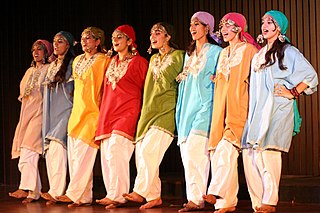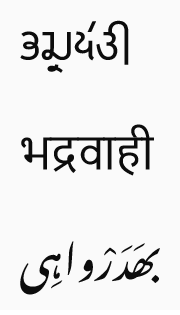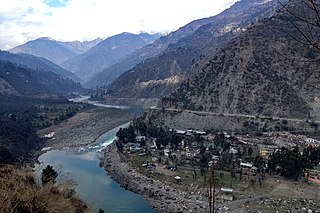
Kashmiri or Koshur is a Dardic Indo-Aryan language spoken by around 7 million Kashmiris of the Kashmir region, primarily in the Kashmir Valley of the Indian-administrated union territory of Jammu and Kashmir. Kashmiri has split ergativity and the unusual verb-second word order.

Doda district is an administrative district of the Jammu division of Indian-administered Jammu and Kashmir in the disputed Kashmir region.

Bhaderwah or Bhadarwah or "Chota Kashmir" is a town, tehsil, sub-division and also additional district in the Doda district of the Jammu Division of Jammu and Kashmir, India. It is also known as Bhadrakashi. The ancient name of Bhaderwah is Bhadravakasa as mentioned in Kalhana's Rajatarangini. For its high literacy rate it is known as Kerala of Jammu and Kashmir.

Kashmiris are an Indo-Aryan ethnolinguistic group speaking the Kashmiri language and originating from the Kashmir Valley, which is today located in Indian-administered Jammu and Kashmir.

Kashmiriyat is the centuries-old indigenous tradition of communal harmony and religious syncretism in the Kashmir Valley in Indian-administered Kashmir. Emerging around the 16th century, it is characterised by religious and cultural harmony, patriotism and pride for their mountainous homeland of Kashmir.

Panun Kashmir is a proposed union territory of India in the Kashmir Valley, which is intended to be a homeland for Kashmiri Hindus. The demand arose after the Exodus of Kashmiri Hindus in 1990. The vision of the homeland was elucidated in the Margdarshan Resolution of 1991. Panun Kashmir is also the name of an eponymously named organization.

The culture of Kashmir encompasses the spoken language, written literature, cuisine, architecture, traditions, and history of the Kashmiri people native to the northern part of the Indian subcontinent. The culture of Kashmir was influenced by the Persian as well as Central Asian cultures after the Islamic rule of Kashmir. Kashmiri culture is influenced by Hinduism, Buddhism and later by Islam.

Paddar, also spelled Padar, is a Sub-District and remote valley in the Kishtwar district of the union territory of Jammu and Kashmir, India. It falls in the Jammu division. It consists of two tehsils namely Machail and Atholi Paddar The valley covers the entire southeastern portion of the Kishtwar district. It borders Zanskar (Ladakh) in the north and east, Pangi in the south and the rest of Jammu and Kashmir in the west. The valley is known for its Sapphire mines. Albeit Sapphires are located in the valley of Paddar in Jammu division, they are known as Kashmiri sapphires which is a misnomer. It lies along the Chandrabhaga river (Chenab) in the Great Himalayas. Paddar is among one of the most remote regions of Jammu and Kashmir. There are a number of small valleys within Paddar, such as Machail, Gandhari, Kabban, Ongai, Bhuzunu, Barnaj, Bhuzas, Kijai Nallah, and Dharlang, among others.

Bhadarwahi (Bhadrawahi) is an Indo-Aryan language of the Western Pahari group spoken by the Bhadarwahi people of the Bhaderwah region of Indian administered Jammu and Kashmir.

The Chenab Valley is a river valley formed by the Chenab River. The term is also used collectively for Doda, Kishtwar and Ramban districts of Jammu Division in the Indian-administered Jammu and Kashmir. These districts were formerly part of a single district, called Doda.
Bhadarwahi, or Bhaderwahi, most often refers to:
Sidhra is a town and municipality in the city of Jammu in the Indian Union Territory of Jammu and Kashmir.

Jammu and Kashmir is a region administered by India as a union territory and consists of the southern portion of the larger Kashmir region, which has been the subject of a dispute between India and Pakistan since 1947 and between India and China since 1959. The Line of Control separates Jammu and Kashmir from the Pakistani-administered territories of Azad Kashmir and Gilgit-Baltistan in the west and north. It lies to the north of the Indian states of Himachal Pradesh and Punjab and to the west of Ladakh which is administered by India as a union territory.

Sarazi or Sirazi is an Indo-Aryan language spoken in the Saraz region of the Jammu division of Jammu and Kashmir, India. It is native to the Saraz region, a hilly area taking up the northern half of Doda district and parts of neighbouring Ramban and Kishtwar districts. Sarazi is spoken as a first language by 46,000 people, primarily Hindus, but it is also used as a lingua franca of the Saraz region and so is also spoken as a second language by Muslims, whom are native speakers of Kashmiri.
Chinta Valley is a valley and a village located 20 kilometres (12 mi) northeast of Bhaderwah town on Bhaderwah-Jai road. It is covered with thick coniferous forests from all sides with a stream flowing through it known as Chinta Nallah. A village called Thuba divides the valley from Bhaderwah.

Bhalessa is a geographical area within Doda district in the Jammu region of India-administered Kashmir. It consists of the Bunjwah and Bhalessa Valleys, and comprises the three Tehsils of Kahara, Chilly Pingal and Gandoh.
The Pahari people or Pahari-speaking people is a cover term for a number of heterogeneous communities inhabiting in Jammu and Kashmir and also some parts of Pakistan administered Azad Kashmir who speak Pahari languages/dialects.
Bashir Bhadarwahi is an Indian writer, educationist and poet, known for his literary criticisms such as Jamis Ta Kasheeri Manz Kashir Natia Abduk Tawareekh. The recipient of numerous awards, including Sahitya Akademi Award, he writes in Kashmiri language.

Brokpa, Drokpa, Dard and Shin is a category of Scheduled Tribes under the Indian constitution.
The Sarazi people are an Indo-Aryan ethnolinguistic group inhabiting the Saraz region of the Jammu division in Jammu and Kashmir, India. Their primary language is Sarazi, classified as a member of the Western Pahari language family. While primarily Hindu, the Sarazi people also include Muslim communities who speak Sarazi as a second language.













